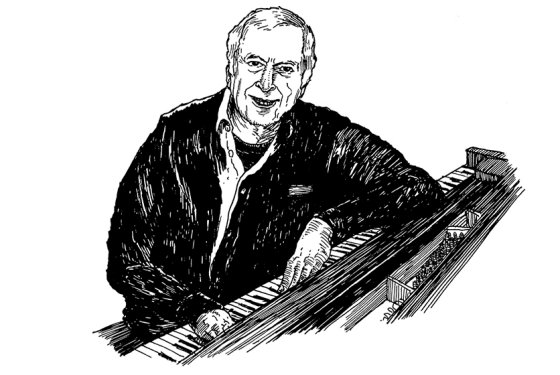
You and Sondheim came up together in the theater world in the fifties. Do you remember when you met?
It wasn’t like, “Mr. Kander, I want you to meet Mr. Sondheim.” We had a number of mutual friends like Bill Goldman. Bill and his brother, Jim, and I lived together in a nine-room apartment on West 72nd Street looking up the Hudson. It was $275 a month. We would sometimes have parties or play Murder. There were a lot of people coming through; some of them disappeared. Certainly Steve and Mary Rodgers are very much here.
That must have been an exciting time to be a young composer.
You have to remember: Steve had not had a show; I had not had a show. None of us had really done anything. You had no one out there saying, “You’re really good!” I was supporting myself coaching singers and doing opera workshops, conducting in stock and doing dance arrangements. We all had our ways of surviving.
So it was like the song “Opening Doors” from Merrily We Roll Along …
I never thought about that, but yeah, in a way it was. It was also a period where you could fail and still work. I remember when Fred Ebb and I started working together, we did a musical called Flora the Red Menace, which Hal Prince produced. Two weeks before the show, Hal said, “Whatever happens, we’ll get together in my apartment the day after and talk about the next piece.” The show was not a success, but the next day we were in his apartment working on a show called Cabaret. I can’t imagine that happening today.
I’ve heard that you worked on Sondheim’s first hit, West Side Story, as a substitute rehearsal pianist.
I happened to be in Philadelphia on the night it opened. I was at that performance, after which there was a party at the Hotel Bellevue Stratford. There were about five people deep trying to get drinks at the bar. I was fairly unaggressive, and a man in front of me saw my distress and said, “Why don’t you tell me what you want; I’ll get yours when I order mine.” We struck up a conversation, and he was a pianist with West Side. We kept in touch, and one day he called to say he was going on vacation and asked if I would be interested in taking over. I said, “Sure!” I said yes a lot in those days.
And then you worked on Gypsy, as dance arranger?
I was playing for the auditions of Gypsy, and Jerry Robbins got used to me being there. At the end of the auditions—and this is an exact quote, I’ll never forget it—Jerry said, “Hey, do you want to do this show with me?” After doing dance arrangements for Gypsy, I got a job doing the same thing for Irma la Douce. The point of this long-winded story is: If I had been sufficiently aggressive to get a drink on the night of West Side Story’s opening, I would never have had a career. It was all a matter of happenstance, which I suppose is a lesson for all shy people.
Do you have any memories of Sondheim from your time on Gypsy?
I remember I was in a room where he and Jule Styne were doing Rose’s Turn and Steve was performing it. It was new, I hadn’t heard it before. It was breathtaking—still the best performance of that that I’ve ever seen in my life.
What a place to be a fly on the wall.
That was a lot of my experience with Gypsy, being a fly on the wall and just watching, learning, being scared, and being happy. I was just dazzled by everything. But it was also very informative about what actually happens when you get into rehearsal, and later in life, on pieces of my own, there would be moments in rehearsal that would remind me of what happened those years before on Gypsy.
Do you and Sondheim share anything artistically?
I just know Steve is an extraordinary writer, and I listen to his work and admire it enormously. When something of his is new or in a workshop, I’m thrilled to be able to tell him how I feel. I remember seeing the run-through of Sunday in the Park when they only had the first act. I understood what he was doing, and I was very moved by it. I couldn’t wait to call him.